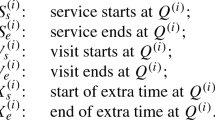Abstract
This paper studies a spatial queueing system on a circle, polled at random locations by a myopic server that can only observe customers in a bounded neighborhood. The server operates according to a greedy policy, always serving the nearest customer in its neighborhood, and leaving the system unchanged at polling instants where the neighborhood is empty. This system is modeled as a measure-valued random process, which is shown to be positive recurrent under a natural stability condition that does not depend on the server’s scan radius. When the interpolling times are light-tailed, the stable system is shown to be geometrically ergodic. The steady-state behavior of the system is briefly discussed using numerical simulations and a heuristic light-traffic approximation.
Similar content being viewed by others
References
Altman, E., & Foss, S. (1997). Polling on a space with general arrival and service time distribution. Operations Research Letters, 20(4), 187–194.
Altman, E., & Levy, H. (1994). Queueing in space. Advances in Applied Probability, 26(4), 1095–1116.
Bertsimas, D. J., & van Ryzin, G. (1993). A stochastic and dynamic vehicle routing problem in the Euclidean plane. Operational Research, 39(4), 601–615.
Borovkov, A. A., & Hordijk, A. (2004). Characterization and sufficient conditions for normed ergodicity of Markov chains. Advances in Applied Probability, 36(1), 227–242.
Borovkov, K. A., & Odell, D. A. (2007). On spatial thinning-replacement processes based on Voronoi cells. Advances in Applied Probability, 39(2), 293–306.
Coffman, E. G. Jr., & Gilbert, E. N. (1987). Polling and greedy servers on a line. Queueing Systems, 2(2), 115–145.
Daley, D. J., & Vere-Jones, D. (2003). Probability and its applications : Vol. I. An introduction to the theory of point processes (2nd ed.). New York: Springer. Elementary theory and methods.
Eliazar, I. (2003). The snowblower problem. Queueing Systems, 45(4), 357–380.
Eliazar, I. (2005). From polling to snowplowing. Queueing Systems, 51(1–2), 115–133.
Ferrari, P. A., Fernández, R., & Garcia, N. L. (2002). Perfect simulation for interacting point processes, loss networks and Ising models. Stochastic Processes and Their Applications, 102(1), 63–88.
Foss, S. (2009). Some open problems related to stability. In Proc. Erlang Centennial Conference, Copenhagen. http://arXiv.org/abs/0909.0462
Foss, S., & Last, G. (1996). Stability of polling systems with exhaustive service policies and state-dependent routing. Annals of Applied Probability, 6(1), 116–137.
Foss, S., & Last, G. (1998). On the stability of greedy polling systems with general service policies. Probability in the Engineering and Informational Sciences, 12(1), 49–68.
Garcia, N. L., & Kurtz, T. G. (2006). Spatial birth and death processes as solutions of stochastic equations. ALEA—Latin American Journal of Probability and Mathematical Statistics, 1, 281–303 (electronic).
Kavitha, V., & Altman, E. (2009). Queueing in space: design of message ferry routes in static adhoc networks. In Proc. 21st international teletraffic congress (ITC-21).
Kendall, D. G. (1951). Some problems in the theory of queues. Journal of the Royal Statistical Society, Series B, 13, 151–173. Discussion: 173–185.
Kroese, D. P., & Schmidt, V. (1994). Single-server queues with spatially distributed arrivals. Queueing Systems, 17(1–2), 317–345.
Kroese, D. P., & Schmidt, V. (1996). Light-traffic analysis for queues with spatially distributed arrivals. Mathematics of Operations Research, 21(1), 135–157.
Leskelä, L. (2010). Stochastic relations of random variables and processes. Journal of Theoretical Probability, 23(2), 523–546.
Litvak, N., & Adan, I. (2001). The travel time in carousel systems under the nearest item heuristic. Journal of Applied Probability, 38(1), 45–54.
Meester, R., & Quant, C. (1999). Stability and weakly convergent approximations of queueing systems on a circle. Preprint 1093, Department of Mathematics, Utrecht University.
Meyn, S. P., & Tweedie, R. L. (1993). Markov chains and stochastic stability. Berlin: Springer. Available online at http://probability.ca/MT/.
Robert, P. (2010). The evolution of a spatial stochastic network. Stochastic Processes and Their Applications, 120(7), 1342–1363.
Rudin, W. (1987). Real and complex analysis (3rd ed.). New York: McGraw–Hill,
Spieksma, F. M., & Tweedie, R. L. (1994). Strengthening ergodicity to geometric ergodicity for Markov chains. Stochastic Models, 10(1), 45–74.
Author information
Authors and Affiliations
Corresponding author
Rights and permissions
About this article
Cite this article
Leskelä, L., Unger, F. Stability of a spatial polling system with greedy myopic service. Ann Oper Res 198, 165–183 (2012). https://doi.org/10.1007/s10479-010-0762-6
Published:
Issue Date:
DOI: https://doi.org/10.1007/s10479-010-0762-6




